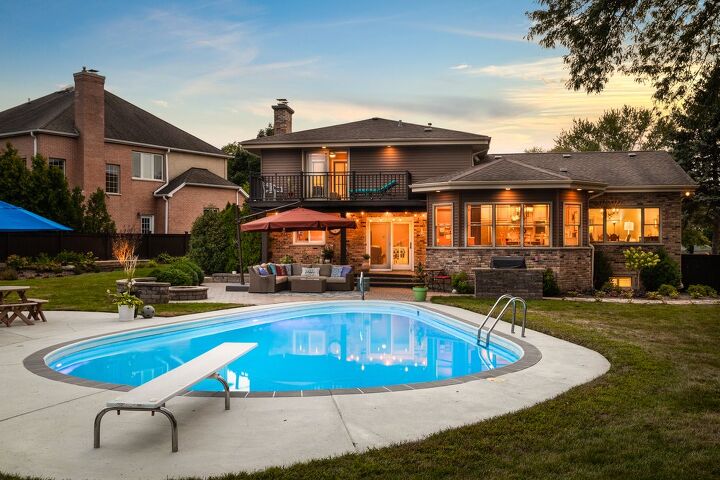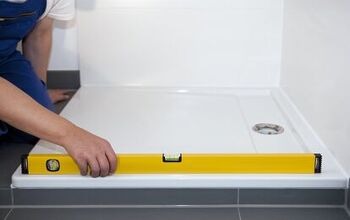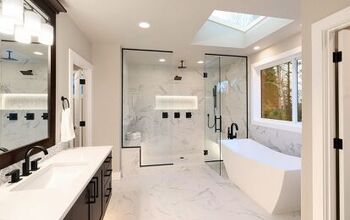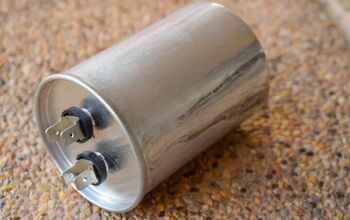Standard Inground Pool Sizes (With Drawings)

A pool can be a great addition to your backyard and add value to your home. And with various standard inground pool sizes to choose from, you don’t always need a giant space. It’s wise to think about how you’ll use your pool and who will use it most often.
Standard inground pools are 12′ x 24′, 14′ x 28′, 15′ x 30′, 16′ x 32′, 18′ x 36′, 20′ x 40′, and 22′ x 44′. These rectangular pools and similarly shaped designs (like kidney) have a 2 to 1 ratio of length to width. Oval pools are also popular and have similar measurements, although they can vary by a couple of feet.
If you’re in the market for a pool, make sure you get a pool size that works well in your yard. Another important consideration is how deep you want your pool to be.
What Are the Most Common Inground Pool Sizes?
Even though pools come in all shapes and sizes, some are more typical than others. The most common standard inground pool sizes are rectangular or kidney-bean shapes or ovals.
Kidney-shaped pools will typically have measurements just slightly off of true rectangular pools. For example, instead of 14′ x 28′, it would be closer to 15′ x 26′. These shapes typically feature the following standard inground pool sizes.
| Rectangular Pool or Kidney-Bean Pool | Oval Pool |
| 12′ x 24′ | 12′ x 26′ |
| 14′ x 28′ | 15′ x 30’6″ |
| 15′ x 30′ | 16′ x 32’9″ |
| 16′ x 32′ | 17′ x 34’6″ |
| 18′ x 36′ | 18′ x 27’8″ |
| 20′ x 40′ | 18′ x 35’8″ |
| 22′ x 44′ | 20′ x 40’1″ |
| 22′ x 39’6″ |
As you can see, rectangular pools tend to follow a 2-to-1 rule when it comes to length and width. The most popular pool size is 16′ x 32′, with a rectangle the most classic shape.
What Is the Best Depth for My Inground Pool?
The average residential pool depth ranges between 3 and 5 feet. But your pool can be deeper or more shallow, depending on your needs and preferences.
To determine the best depth for your inground pool, consider who will use it and why. Pools for kids and adults should have a maximum depth of five feet and a minimum depth of three feet.
If you plan to play recreational sports, people need to stand up, so a maximum of four feet is ideal. When jumping feet first into the pool, that part of the pool should be at least four feet deep. If there is a diving board, the diving end of the pool usually needs a 10-foot depth.
A pool with multiple depths is best if you plan to use your pool for different uses. You might have a shallow, three-foot deep area for lounging that gradually shifts to five feet deep for jumping. Also, your pool’s depths in different areas will influence what type of entrance and exit you need.
How Much Water Does Each Inground Pool Size Hold?
The pool’s depth will greatly influence how much water it takes to fill your pool. Considering an average depth of 4 feet, here’s how much water some popular rectangular inground pool sizes hold.
| Pool Size | Amount of Water |
| 12′ x 24′ | 8,640 gallons |
| 14′ x 28′ | 11,760 gallons |
| 15′ x 30′ | 13,500 gallons |
| 16′ x 32′ | 15,360 gallons |
| 18′ x 36′ | 19,440 gallons |
| 20′ x 40′ | 24,000 gallons |
| 22′ x 44′ | 29,040 gallons |
To find the amount of water needed to fill a rectangular pool, simply multiply the length x width x depth x 7.5. You find the capacity of an oval pool by multiplying length x width x depth x 5.9. If you have a circular pool, multiply the diameter x diameter x depth x 5.9.
If you have an odd-shaped pool, such as an L-shape, find the capacity of each section. Then, you can add them together for your total amount of gallons.
What Size Inground Pool Do I Need?
When you look at the standard inground pool sizes and various depths, what size is best for you? You certainly should think about how you plan to use your pool. For example, is it mainly for relaxing and soaking up rays, or are you a serious swimmer?
Is it just you and a few friends using it, or do you have a large family? Do you plan to host pool parties?
Video: What Size Pool Do I Need?
The answers to these questions will significantly impact if you go with a smaller (12′ x 24′) or larger pool (22′ x 44′). But, you also must factor in another huge component–your available yard space.
How Big Does Your Backyard Need To Be For A Pool?
In general, your pool and the surrounding pool deck should only occupy between 25% and 35% of your backyard area. If you’re passionate about swimming and are okay with the pool taking up more room, it might take up to 45% of your yard.
Therefore, if you want the most popular pool size, 16′ x 32′, you’d need a yard of at least 3,500 sqft. This yard size would mean your pool and the surrounding area would take up roughly 45% of your yard. If you only want it to take up 25%, your yard would need to be about 6,000 sqft.
How Much Space Do You Need Around a Pool?
Remember, the 25% to 45% figures include the area surrounding the pool. Most codes require a minimum of between 42 to 48 inches on each side of the pool. Therefore, a 12′ x 24′ pool would create an entire pool area of at least 24′ x 40′.
This space provides sufficient walkways and room for people to get in and out of the pool. It also allows for simple pool chairs. If you want to fit larger seating or lounge areas or a grill area, you’ll need even more space around the pool.
Remember, you need to leave adequate walk space between these items and the pool’s edges. Keep all of these things in mind when designing your pool deck.
How Far Should an Inground Pool Be From the House?
Many municipalities require an inground pool to be at least 25 feet away from any of the home’s exterior walls. But, this number can vary based on location, so check with your local authority before making any plans. It’s also wise to make sure you can put your pool where you want it before beginning the process.
How Far Does an Inground Pool Need to Be from the Property Line?
Check your local codes to determine how far your pool must be from your property line. This will affect the size of your pool since you need to factor it into your total area.
Some typical setbacks are at least three feet from a fence and five feet from the rear boundary of the yard and interior side yard. Additionally, the street side of the yard needs a 10-foot setback and the front yard a 20-foot setback. You also need to consider the distance of things like electrical receptacles, which typically must be at least 6 feet away.
How to Measure for an Inground Pool
- Determine your overall pool area by taking 25 to 35% of your total yard square footage.
- Take this area and measure out the length and width.
- Deduct 8 feet from the width and 8 feet from the length to determine your maximum pool size.
For example, if your yard is 6,240 square feet, 25% is 1,560 square feet. When you measure the area, you get a length x width of 30 x 52. Deducting 8 feet from the width and length to accommodate your minimum pool deck gives you a pool size of 22′ x 44′.
Keep in mind when measuring for a pool to also account for any local property line easements and setbacks.
What Does an Inground Pool Cost?
The cost of a pool considers many factors, like size, shape, materials, and extras. But you can pay between $28,000 and over $65,000 when you start adding in lighting and special features. The average cost for an inground pool tends to fall around $35,000.
Conclusion: Comparing Inground Pool Sizes
Pools provide a lot of fun in a backyard, and you have many sizes and shapes to choose from. The most common inground pool is a rectangular pool, and it features many standard inground pool sizes. The most popular rectangular pool size is 16′ x 32′.
Standard inground pool sizes also come in 12′ x 24′, 14′ x 28′, 15′ x 30′, 18′ x 36′, 20′ x 40′, and 22′ x 44′. Rectangular pools usually have a length twice the width. If you opt for an oval or kidney-shaped pool, they will have similar sizes that vary slightly.

Stacy Randall is a wife, mother, and freelance writer from NOLA that has always had a love for DIY projects, home organization, and making spaces beautiful. Together with her husband, she has been spending the last several years lovingly renovating her grandparent's former home, making it their own and learning a lot about life along the way.
More by Stacy Randall



























![Cost To Drill A Well [Pricing Per Foot & Cost By State]](https://cdn-fastly.upgradedhome.com/media/2023/07/31/9074980/cost-to-drill-a-well-pricing-per-foot-cost-by-state.jpg?size=350x220)




